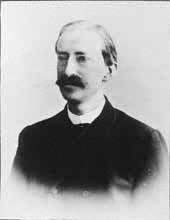George Arnold Escher
George Arnold Escher (10 May 1843 – 14 June 1939) was a Dutch civil engineer and a foreign advisor to the Japanese government during the Meiji period.[1][2]
George Arnold Escher | |
|---|---|
 | |
| Born | 10 May 1843 |
| Died | 14 June 1939 (aged 96) |
| Nationality | Dutch |
| Occupation | civil engineer |
He was the father of the graphic artist M. C. Escher and the geologist Berend George Escher.
Career
Escher was hired by the Japanese government as a foreign advisor from September 1873 to July 1878, along with fellow Dutch civil engineers Johannis de Rijke and Cornelis Johannes van Doorn.[1] During his stay in Japan, he designed and supervised the restoration of the Yodo river (Osaka), and built a harbour in Mikuni in Fukui prefecture.
After returning to the Netherlands, he worked in Maastricht. During this time, he recorded in his diary his difficulty as a Protestant in finding a suitable marriage partner in Roman Catholic Maastricht who would also be able to satisfy his equation v = 1/2m + 10, where v was the age of the woman, and m the age of the husband.[3] In 1882, Escher married Charlotte Marie Hartitzsch, with whom he had two sons. He became a widower in 1885, and in 1892 married Sara Gleichman, with whom he had three more sons. Escher worked as a hydraulic engineer in Leeuwarden. In 1903 the family moved to Arnhem.
Notes
- Louman, Johannes. (2007). Fries waterstaatsbestuur, p. 127., p. 127, at Google Books
- van Gasteren, Louis, ed. (2003). Die Eeuwige Rijst met Japansche Thee: Brieven uit Japan van Nederlandse Watermannen, 1872–1903. Uitgeverij Bas Lubberhuizen. ISBN 9789059370241.
- "v = 1/2m + 10". Archived from the original on December 15, 2005. Retrieved June 5, 2007.CS1 maint: unfit url (link)
References
- Kamibayashi, Yoshiyuki. "Two Dutch Engineers and Improvements of Public Works in Japan," Proceedings of the Third International Congress on Construction History, Cottbus, May 2009.
- Louman, Johannes Petrus Antonius. (2007). Fries waterstaatsbestuur: : een geschiedenis van de waterbeheersing in Friesland vanaf het midden van de achttiende eeuw tot omstreeks 1970. Amsterdam: Amsterdam University Press. OCLC 150391614
External links
- "w = 1/2m + 10". Archived from the original on December 15, 2005. Retrieved June 5, 2007.
- 御雇オランダ人工師エッセルの「阪井港修築建議」の現代文訳
Further reading
- Kamibayashi, Yoshiyuki (1999). "The Background of GA. Escher, Hollander Engineer who supported Jode Rijke for 40 years". Historical Studies in Civil Engineering. 19: 399–406. doi:10.2208/journalhs1990.19.399.